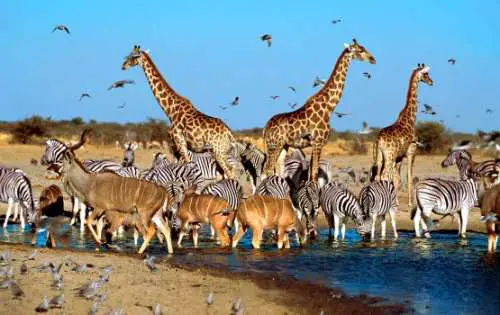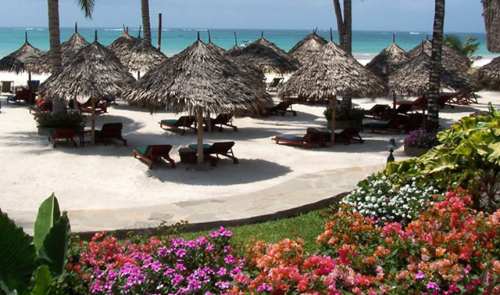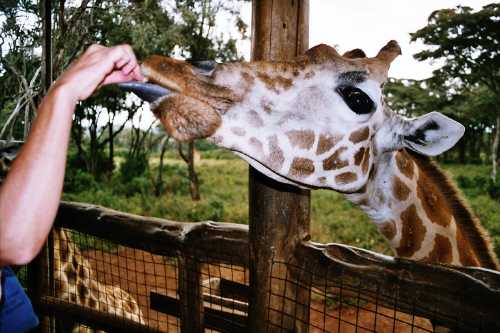Top 10 Best Tourist Attractions in Kenya
Kenya is one of the countries with the most beautiful sceneries, coast, and wildlife. There are several places to visit but in this article, I will be telling you about the top 10 best tourist attractions in Kenya.
1. Maasai Mara National Reserve
Maasai Mara National Reserve, often referred to as Masai Mara, stands as a remarkable African game reserve situated at the northern extension of the Serengeti, forming a vital wildlife corridor connecting Kenya and Tanzania. Named after the Maasai people, who have nurtured their livestock here for centuries, the term “Mara” in their language describes the interplay of light and shadow across the expansive grasslands, enhanced by acacia trees and cloud-strewn skies.
This reserve gained renown for the Great Migration, an annual spectacle involving the movement of numerous wildebeest, zebra, and Thomson’s gazelle between the Serengeti and Masai Mara from July to October. The Mara River meanders through the landscape, inhabited by groups of hippos and lurking crocodiles. The reserve’s notable predator populations, including lion, cheetah, and leopard, offer exceptional viewing opportunities, especially from December to February during the drier months.
Blessed with a mild and temperate climate year-round owing to its elevated altitude, the Maasai Mara National Reserve remains a captivating destination for nature enthusiasts.
2. Amboseli National Reserve
Nestled beneath the towering presence of Mount Kilimanjaro, Africa’s highest summit, Amboseli National Reserve emerges as a cherished destination within Kenya’s tourist landscape. The name “Amboseli,” originating from the Maasai language, translates to “salty dust,” an apt depiction of the reserve’s arid environment.
This park stands as an exceptional site in Africa for observing sizeable elephant herds from close proximity. Alongside these majestic creatures, Amboseli is home to an array of wildlife, including prominent predators like lions and cheetahs, as well as giraffes, impalas, elands, waterbucks, gazelles, and over 600 bird species.
Enthusiasts of nature can explore a diverse range of five distinct habitats within the reserve, encompassing the desiccated bed of Lake Amboseli, wetlands with sulfur springs, expansive savannahs, and lush woodlands. Within the vicinity, one may encounter the indigenous Maasai people, who inhabit the surrounding areas of the park.
3. Tsavo National Park
Tsavo, Kenya’s largest national park, is divided into Tsavo West and Tsavo East. These two parks collectively cover four percent of the country’s land area and encompass a diverse range of landscapes, including rivers, waterfalls, savannahs, volcanic hills, a massive lava-rock plateau, and a rich array of wildlife.
Positioned midway between Nairobi and Mombasa, Tsavo East is renowned for its captivating scenes of expansive elephant herds, gracefully rolling and bathing in crimson-hued dust, making it an exceptional setting for impressive photography. The Galana River, fringed with palm trees, meanders through the park, offering excellent opportunities for observing wildlife and creating a lush contrast to the surrounding arid plains.
Additional attractions in Tsavo East include the Yatta Plateau, which boasts the world’s longest lava flow; Mudanda Rock; and the dynamic Lugard Falls, cascading into rapids and pools inhabited by crocodiles.
Conversely, Tsavo West is characterized by greater topographical diversity and higher rainfall. It showcases some of the most picturesque vistas in the northern section of the park. Noteworthy spots in this area include Mzima Springs, a collection of natural springs teeming with hippos and crocodiles; Chaimu Crater, an excellent location for observing birds of prey; and Ngulia Rhino Sanctuary.
Although the denser vegetation in Tsavo West makes wildlife sightings slightly more challenging, the stunning landscapes more than compensate for this, providing a truly captivating experience.
4. Samburu, Buffalo Springs, and Shaba National Reserves
Nestled along the palm-fringed Ewaso Nyiro River, the Samburu, Buffalo Springs, and Shaba Reserves are situated in the arid expanse of northern Kenya. Notably, Shaba National Reserve holds historical significance as one of the locations where George and Joy Adamson nurtured Elsa the Lioness, renowned for the iconic film Born Free.
These reserves rely on the river’s life-giving waters to sustain their diverse wildlife, showcasing species uniquely adapted to the harsh environment. Among these remarkable creatures are Grevy’s zebras, Somali ostriches, and gerenuks – the elegant, long-necked antelopes known for their distinctive stance on two hind legs as they reach for tender foliage on high tree branches.
An eminent highlight within Samburu National Reserve emerges as the Sarara Singing Wells – indigenous watering spots where Samburu warriors engage in harmonious serenades while procuring water for their cattle. The reserve also offers exciting chances to encounter majestic big cats and elusive wild dogs, adding to its allure.
5. Lake Nakuru National Park
Lake Nakuru National Park, located in Central Kenya, is renowned for its vast gatherings of pink flamingos adorning Lake Nakuru, one of the Rift Valley’s soda lakes spanning nearly a third of the park.
Established in 1961, the park hosts over 450 bird species and a diverse array of wildlife, including lions, leopards, warthogs, waterbucks, pythons, and white rhinos. The terrain varies from expansive grasslands by the lake to rugged cliffs and woodlands.
This park safeguards Africa’s largest euphorbia candelabrum forest, a unique feature of the region with its tall, branching succulents that enhance the arid landscapes.
6. Lamu Island
Lamu Island is a captivating destination located along the Kenyan coast. Known for its rich history, Swahili architecture, and stunning natural beauty, Lamu Island offers a unique and unforgettable experience for travelers.
Key highlights of Lamu Island include:
(a). Historical Significance: Lamu Island is one of the oldest and best-preserved Swahili settlements in East Africa. Its historical town, Lamu Town, is a UNESCO World Heritage Site and is characterized by narrow streets, intricately carved doors, and unique architecture influenced by various cultures.
(b). Cultural Experience: The island’s culture is a blend of African, Arab, and Indian influences. Visitors can explore the local markets, interact with friendly residents, and participate in traditional festivals and events.
(c). Beaches: Lamu Island boasts stunning sandy beaches with clear blue waters. Shela Beach is a popular spot for relaxation, water activities, and enjoying breathtaking sunsets.
(d). Water Sports: The island offers opportunities for various water sports such as snorkeling, diving, sailing, and dhow (traditional wooden boat) trips. The surrounding marine life and coral reefs make it a paradise for underwater enthusiasts.
(e). Manda Island: Accessible by boat from Lamu Town, Manda Island features the atmospheric ruins of Takwa, an ancient Swahili trading settlement. It’s an excellent spot for history enthusiasts and those interested in archaeology.
(f). Donkey Transport: One of the unique features of Lamu Island is that there are no motorized vehicles on the island. Donkeys are the primary mode of transport, adding to the island’s charming and laid-back atmosphere.
(g). Lamu Museum: A visit to the Lamu Museum provides insight into the island’s history, culture, and traditions. It showcases artifacts, exhibitions, and displays related to Lamu’s heritage.
(h). Culinary Delights: Sample delicious Swahili cuisine, including fresh seafood, coconut-based dishes, and local spices. Dining on the island offers an authentic and flavorful experience.
(i). Relaxation and Tranquility: Lamu Island’s serene and peaceful environment makes it an ideal destination for relaxation, meditation, and rejuvenation.
Whether you’re intrigued by history, culture, water adventures, or simply seeking a tranquil escape, Lamu Island offers a blend of experiences that make it a truly exceptional destination in Kenya.
7. Nairobi National Park
Nairobi National Park is a one-of-a-kind wildlife sanctuary located just outside Nairobi, Kenya’s bustling capital city. It offers a rare opportunity to experience a variety of wildlife and stunning landscapes in close proximity to an urban center.
Key features and attractions of Nairobi National Park include:
(a). Wildlife Diversity: Despite its proximity to the city, the park is home to a wide range of animals, including lions, giraffes, zebras, rhinos, buffalo, and various antelope species. Visitors can embark on game drives to observe these animals in their natural habitat.
(b). Convenient Access: Nairobi National Park’s close proximity to Nairobi makes it easily accessible for both local and international visitors. It provides a convenient way to witness African wildlife without having to travel far from the city.
(c). Scenic Views: The park offers panoramic views of the city skyline against the backdrop of open grasslands, making for unique and picturesque photo opportunities.
(d). Rhino Sanctuary: The park hosts a dedicated rhino sanctuary that plays a vital role in rhino conservation efforts. It provides a safe haven for both black and white rhinos, which are critically endangered species.
(e). Birdwatching: The park boasts a diverse bird population, making it a paradise for birdwatchers. Over 400 bird species have been recorded in the park, including ostriches, secretary birds, and various raptor species.
(f). David Sheldrick Wildlife Trust: Located within the park, this trust is dedicated to the rehabilitation and care of orphaned elephants and rhinos. Visitors have the opportunity to observe these young animals during feeding times.
(g). Walking Trails: Nairobi National Park offers walking trails and picnic areas, providing a chance to explore on foot and enjoy a relaxing outdoor experience.
(h). Ivory Burning Site Monument: A significant historical site within the park, the Ivory Burning Site Monument commemorates Kenya’s efforts to combat the illegal ivory trade by burning confiscated ivory.
(i). Conservation and Education: The park serves as an important center for conservation awareness and education, highlighting the importance of protecting wildlife and their habitats.
(j). Night Safari: Nairobi National Park also offers unique night safaris, allowing visitors to witness the park’s nocturnal wildlife activity under the guidance of experienced rangers.
Nairobi National Park is a testament to Kenya’s commitment to wildlife conservation and its harmonious coexistence with urban development. It provides an exceptional opportunity to experience Africa’s iconic wildlife against the backdrop of a vibrant city, making it a must-visit destination for nature and animal enthusiasts.
There are more places to visit in Nairobi for tourist attractions and safaris. Check out some of the best destinations for a safari from Nairobi.
8. Giraffe Centre
Situated near the David Sheldrick Wildlife Trust Elephant Nursery, the Giraffe Center is a captivating attraction in close proximity to Nairobi National Park. Its primary focus is on restoring and reintroducing the Rothschild Giraffe to Kenya’s wildlife reserves. During a brief presentation lasting 15 to 20 minutes, the dedicated staff explain their conservation efforts.
A visit to this center offers an intimate encounter with these graceful giants. Armed with a bowl of giraffe food, you’ll have the opportunity to feed these inquisitive creatures. The feeding area, elevated on a platform, brings you to eye level with the giraffes. With gentle inclination, they extend their enormous blackish-grey tongues to partake in the treats you offer.
While the giraffes may steal the spotlight, the property is also frequented by several warthogs, eager to share in the giraffe food if you’re inclined to engage with them.
9. Mombasa
Mombasa, Kenya’s second-largest city and prominent port, exudes a multicultural charm that magnetizes tourists. The city’s fabric is woven with the influences of British, Portuguese, Arab, Indian, and Asian immigrants, which manifest in its architecture and diverse culinary offerings.
Positioned as an island, Mombasa is connected to its burgeoning mainland development through bridges, a causeway, and ferries. The coastline, extending for 480 kilometers, is adorned with vibrant coral reefs, creating a haven for snorkeling and diving enthusiasts. Notably, Mombasa Marine National Park and the vicinity of Wasini Island offer exceptional opportunities for underwater exploration. Dolphin watching and deep-sea fishing are also sought-after activities here.
The Kenyan coast surrounding Mombasa boasts an array of tourist attractions. History lovers can delve into the 16th-century Fort Jesus and the charm of Old Town, characterized by its ancient Swahili residences, bustling markets, and souvenir emporiums.
Mombasa’s northern shore is teeming with additional attractions, including Mombasa Go-Kart, cinemas, sports facilities, and a diverse array of dining establishments.
Given its coastal essence, Mombasa is a haven for beach enthusiasts. Nyali and Bamburi Beaches to the north, as well as the alluring stretches of Shelly, Tiwi, and Diani Beaches to the south, beckon with their white sands and azure waters.
10. Ol Pejeta Conservancy
Ol Pejeta Conservancy, situated approximately 200 kilometers north of Nairobi and near Mount Kenya National Park, offers unparalleled wildlife encounters in a 90,000-acre private game reserve.
At this conservancy, focused on conservation and sustainability, visitors can witness the iconic Big Five (lion, leopard, rhino, elephant, and buffalo) up close, along with an array of other fascinating creatures including cheetahs, hyenas, zebras, and hartebeests. These captivating sightings unfold against the awe-inspiring backdrop of Mount Kenya’s snow-capped peaks.
The conservancy stands out for its dedication to northern and southern white rhinos, among them Baraka, a remarkable blind black rhino, whom fortunate guests might even have the chance to feed.
Exploration is facilitated through self-drive or guided tours, with admission encompassing a visit to the chimpanzee sanctuary. Day visitors are warmly welcomed, while those seeking an extended wilderness experience can opt for overnight stays in diverse accommodations ranging from bush camps and safari cottages to charming colonial ranch houses.
You can also visit these other places with beautiful scenery:
- Mount Kenya: The country’s highest peak, ideal for trekking and mountaineering.
- Diani Beach: Offers pristine white sand, turquoise waters, and water sports.
- Hell’s Gate National Park: Known for its dramatic landscapes and outdoor activities like hiking and rock climbing.






